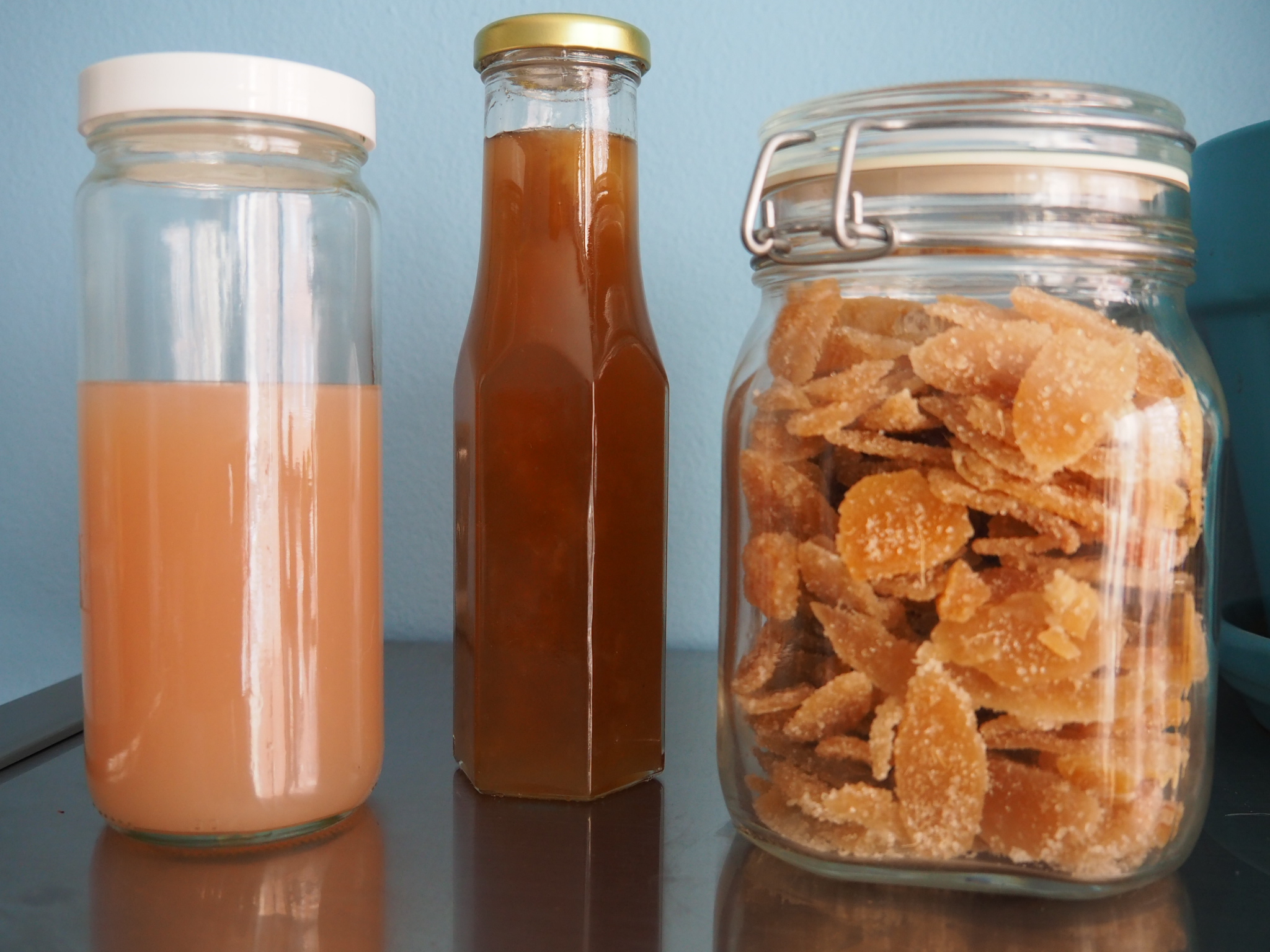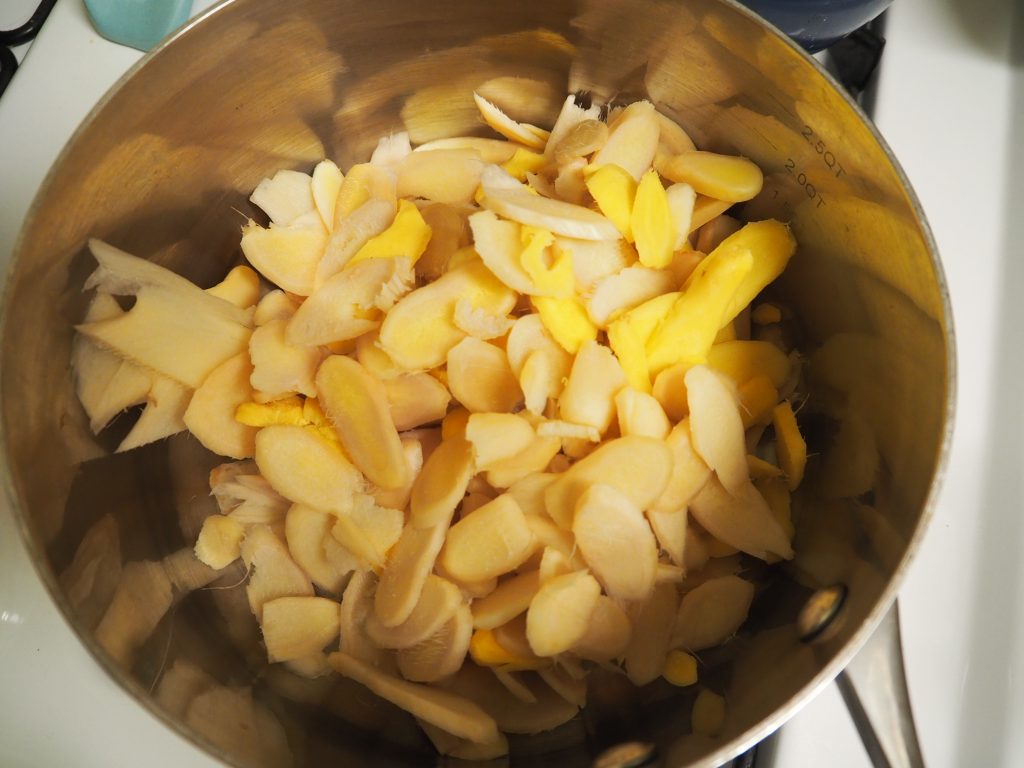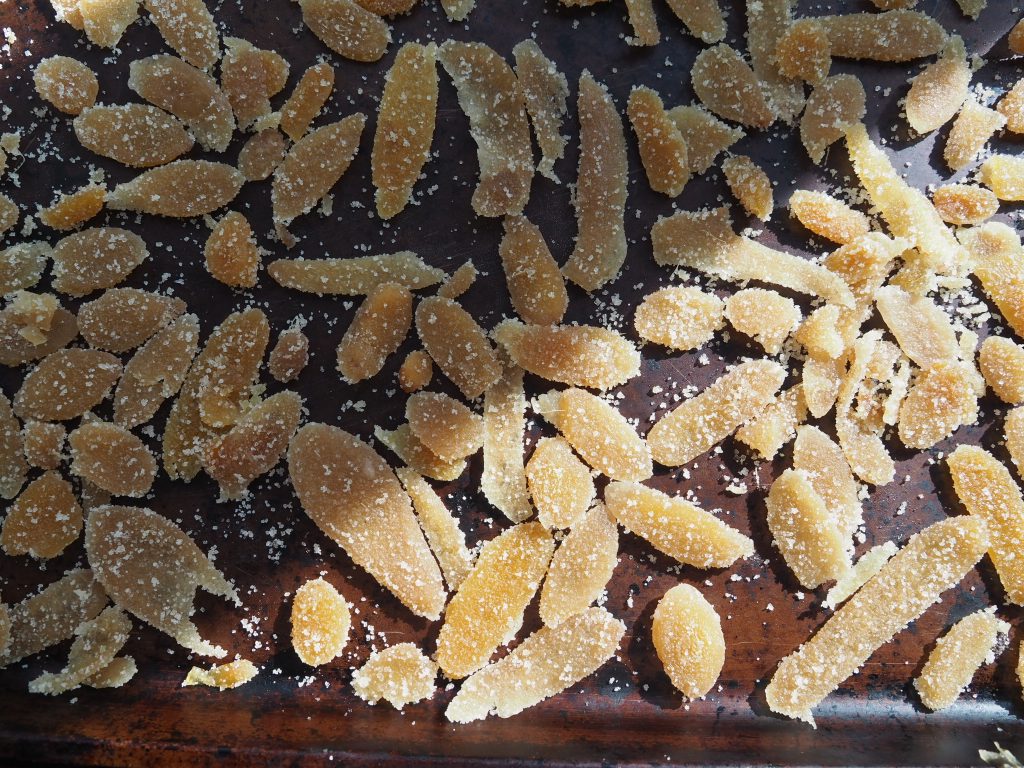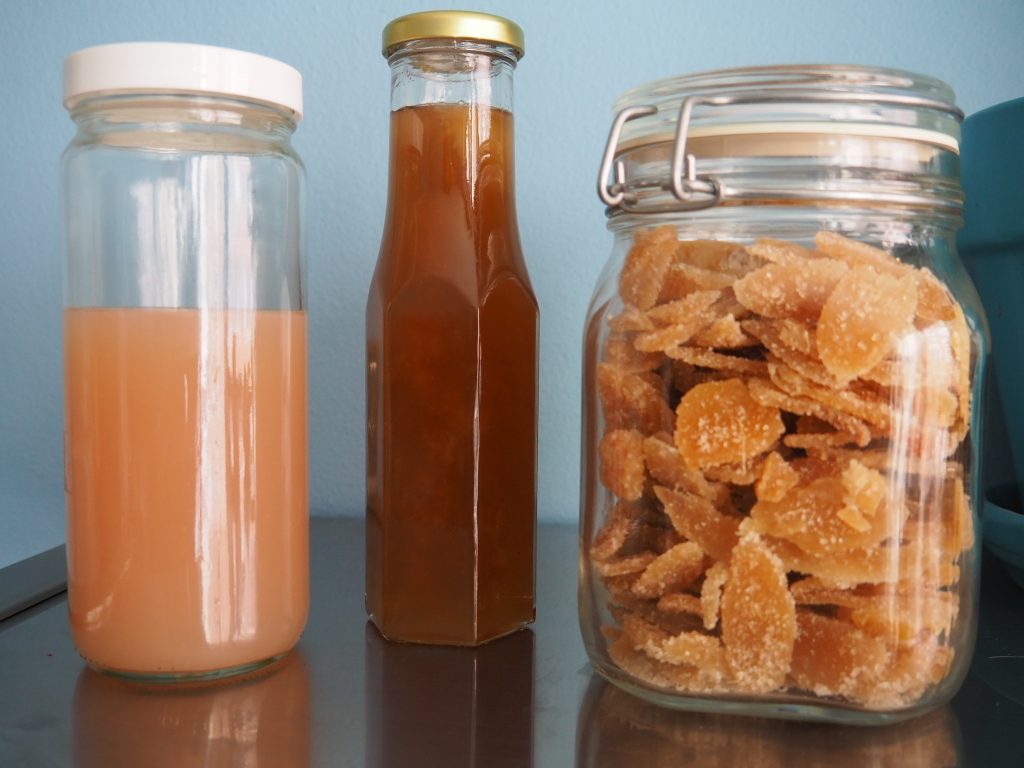In Traditional Chinese Medicine, ginger is one of the most commonly used “herbs” in our toolkit. In this article, I’ll teach you what it can help with as well as some information about how it’s viewed from a Chinese Herbal standpoint. And as promised, I’ll give you a quick explanation for how to make your own crystallized ginger at home, which will also give you ginger tea and syrup. So. delicious.
As an acupuncturist and herbalist, here are the situations where I recommend ginger tea the most frequently:
- People who tend to feel cold, tired and achy often- ginger is warming and energizing, so regular consumption can help (1-2 cups of weak ginger tea daily or a few slices of crystallized ginger- not too much)
- Pregnant women feeling nauseated (“morning sickness”) when there is also an aversion to cold or raw foods such as salads, and/or who find themselves very sensitive to smells (same amount as above)
- Women with menstrual cramps that improve after applying a heating pad. This is a sign of cold in the body and since ginger is very warming, it may help
- People who have or are getting over a cold where there is a lot of persistent phlegm/mucus which is white or clear and thin
Please keep in mind that I am not suggesting ginger on its own is a cure for these issues- it’s simply an easy at-home remedy which can help move your health in the right direction along with an individualized plan from your health care providers.
How Does Traditional Chinese Medicine View Ginger?
I find it very interesting that depending on the type and preparation, ginger has very different uses. Most commonly, we use either Sheng Jiang (zingiberis Rhizoma recens) or Gan Jiang (Zingiberis Rhizoma). Sheng Jiang is the fresh, young ginger found in spring and summer. It’s warm, acrid and good for certain types of nausea and vomiting, stomach pain, common colds, and coughing with phlegm. In contrast, Gan Jiang is the “ginger mother”- the dried, older, more fibrous root found in winter that has a deeper yellow color. It actually has a much hotter quality and is very drying, and is used for digestive and respiratory problems such as diarrhea, coughing and wheezing or even for stopping certain types of bleeding.
It’s important to remember that in Traditional Chinese Medicine herbalism, we almost never use one herb at a time, by itself. It is combined with other herbs in order to fine-tune the effect on the person’s body. The other thing to remember is that there is no one herb that’s good for everyone. Ginger is a clear example- it’s considered either warm or hot depending on the type used, therefore a person who already has a lot of signs of warmth in their body (a high fever with sweating, they always feel hot or have red cheeks or even tend to get easily flushed or have night sweats) should either avoid ginger or have very small amounts of it. Too much will increase the heat and make them feel worse. However for normal consumption at home, it’s generally very safe as long as consumed in reasonable amounts. If you have questions, ask your acupuncturist/herbalist or doctor.
How To Make 3 Preparations of Ginger in One Project:
There are so many ways to enjoy this spicy, warming root. In this article I’ll explain how you can simultaneously make crystallized ginger, strong ginger tea and ginger syrup. It all started when I decided to try making crystallized ginger, then realized that the by-products of the process were the tea and the syrup. I love ginger and eat it every chance I get so I was really excited with the unexpected bonuses.
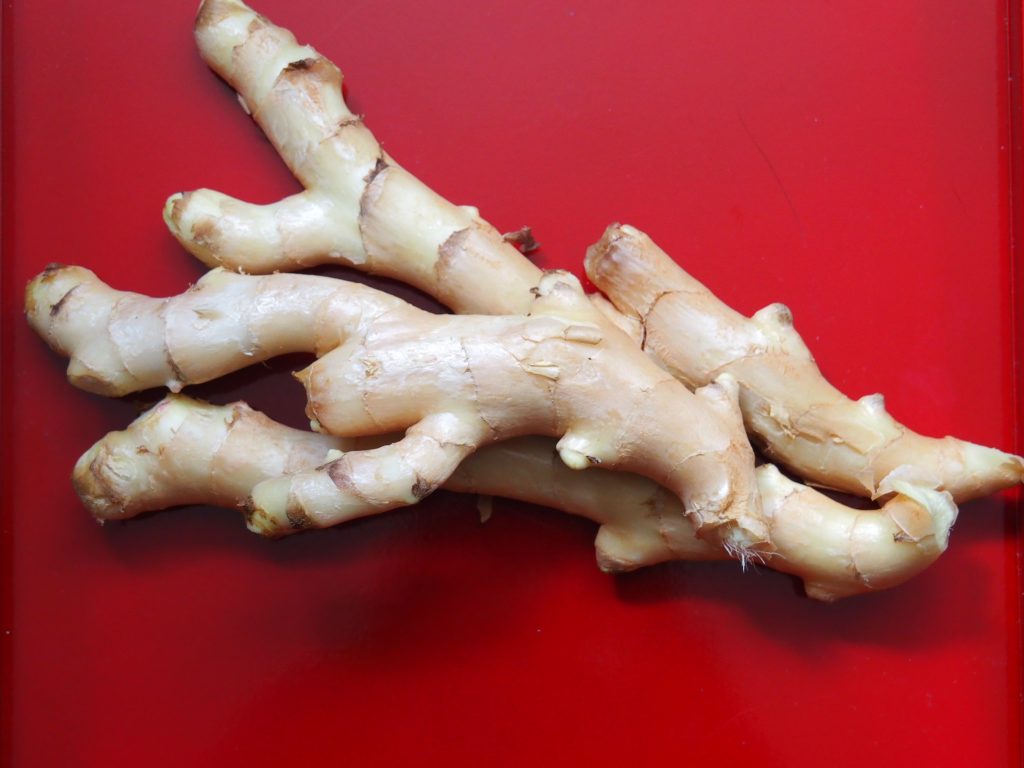
Sheng Jiang- young ginger found in the spring or summer. This is the easiest kind to use when making crystallized ginger. Note the long pieces- easier for cutting into slices!
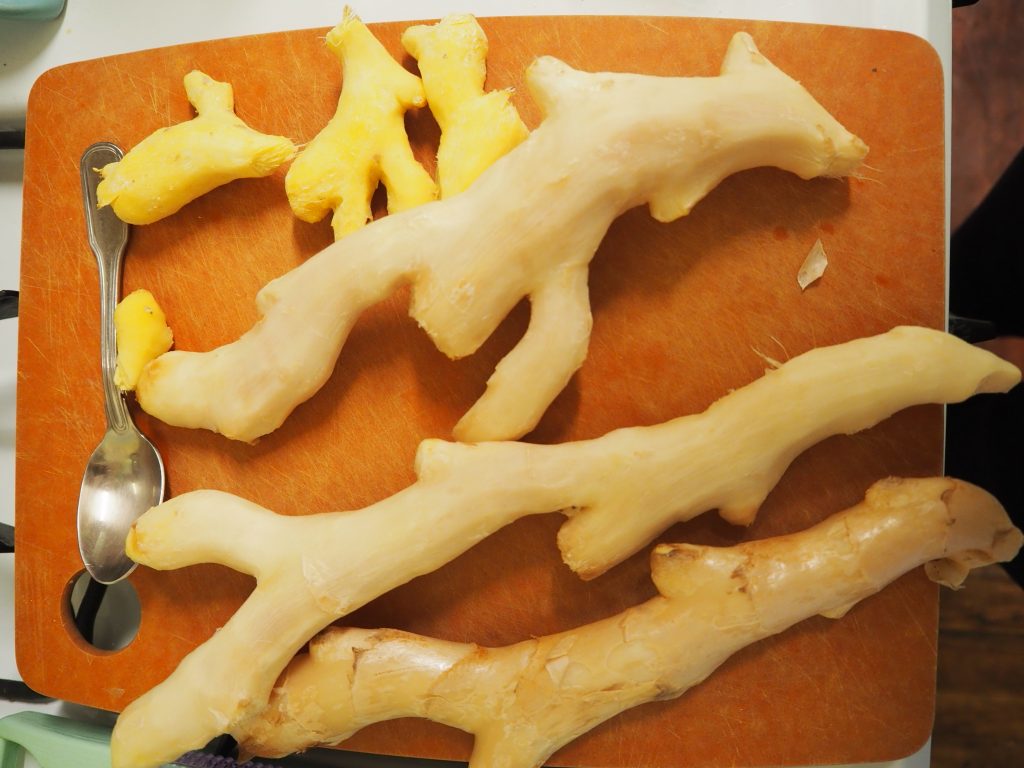
Peeled sheng jiang (young ginger) and one unpeeled piece at the bottom of the photo. These are the longer, pale pieces. The darker yellow ginger is gan jiang- its tougher, more fibrous and has a stronger smell. It is fine to use but will be more work to peel and cut.
Tips before starting the process:
- This is a really interesting and fun project. However, it is a PROJECT. Between peeling the ginger and having all 3 products at the end, it took me about 3 hours. However, it’s totally worth the time and much of it can be spent doing other things (such as when the ginger is boiling for 20 minutes, two times). So put on your favorite podcast, make a cup of tea and enjoy the meditative process of making something new with your hands. Since it takes a long time, it’s worth it to make a lot at once. I used about a pound of fresh ginger, but it wouldn’t take much more time to make 2 pounds (and then you’re all set for holiday/birthday gifts for the year)!
- I recommend using true Sheng Jiang- if you can, get the young ginger in the spring or summer. It’s currently April 2020 and I was able to find some really beautiful, tender ginger at Whole Foods that was quick to peel because the skin is so thin.
- Have a few glass jars ready- one large jar for the crystalized ginger and one each for the ginger tea and syrup.
The Recipe:
You’ll need:
- About 1 lb ginger (try to find young ginger which has thin skin and as many long, straight pieces as possible- it’s not mandatory but makes things much easier)
- Granulated Sugar- about 3 cups per pound of ginger
- Water
The process:
- Wash and peel the ginger. I find it easiest to use a small, sturdy spoon to peel with and get around all the little nooks and knobs
- Chop the ginger into slices as thinly as possible. You can use a mandoline but I found that a knife gave me the best results personally. You can cut on the bias for longer, oval-shaped pieces or straight across for smaller, round pieces.
- Place all your ginger slices into a large pot and cover with a few inches with water. Simmer for 20 minutes. This helps to tenderize the ginger and take away some of the spiciness. After it’s finished simmering, strain out the ginger but SAVE THE WATER! This is your deliciously strong ginger tea. After it’s cooled a bit, pour into a jar and refrigerate for later use.
- Repeat step 3- simmer the ginger again for 20 minutes. No need to save the water this time, although you could if you want some slightly weaker ginger tea.
- Strain out the water, then again cover the ginger to about an inch above the top of it with water. Add about 3 cups of granulated sugar (don’t skimp or it won’t crystallize) and stir. Boil on high until the liquid is even with the ginger. At this point, reduce the heat to medium until you notice the liquid getting very thick and syrup-like. Reduce the heat to low and frequently stir the ginger to keep it from burning. This is where you need to watch closely. You should see some of the sugar on the sides of the pot start to crystallize a bit, as well as the ginger. But- please don’t stress about this step! I have seen recipes online which recommended using a candy thermometer and stopping the boil when it reached a certain temperature. This is totally not necessary. Just keep a close eye to make sure it doesn’t burn and the syrup level doesn’t get too low.
- Strain out the syrup, and save it! This is your deliciously strong ginger syrup, which can be used on… anything and everything. It’s amazing. Press as much syrup out of the ginger pieces as possible.
- Grab two baking sheets and evenly scatter a thin layer of granulated sugar on each one. Then, gradually spread the ginger pieces on the baking sheets. Using your fingers (yes they will get sticky), separate the ginger pieces and try to coat each one in the sugar (see photo below of what this will look like). This helps to dry them out and keeps them from sticking together after cooled. It may sound tedious, but if you have a seat and continue playing your music or podcast, it will feel meditative.
- Allow to cool for a few hours or overnight, then put in a tightly sealed jar with a little more granulated sugar (this will help to keep it dry). Voila!
The Final Products
Some ideas for using each of your gingery treats:
Ginger tea:
- Add 1-2 TBSP to any other type of herbal tea for a gingery kick
- Ginger tea is better than plain ginger root at settling the stomach and reducing nausea as well as breaking up phlegm to reduce coughing- dilute the tea made from this recipe by 1/3 to 1/2 with water and drink 2-4 cups per day. Reduce consumption if you start to notice your throat becoming dry or you feel hot
- Mix half ginger tea and half green tea to moderate the symptoms of traveler’s diarrhea (severe vomiting and diarrhea). Sip slowly
Ginger Syrup:
- Drizzle over pancakes or waffles, fruit, oatmeal or yogurt
- Use in place of honey or maple syrup for baking
- Use in place of simple syrup in cocktails
Crystallized Ginger:
- Chop and add to fruit crumbles
- Add to granola bars or simply eat a few pieces at a time for a snack
- Chop and add to a stir fry

